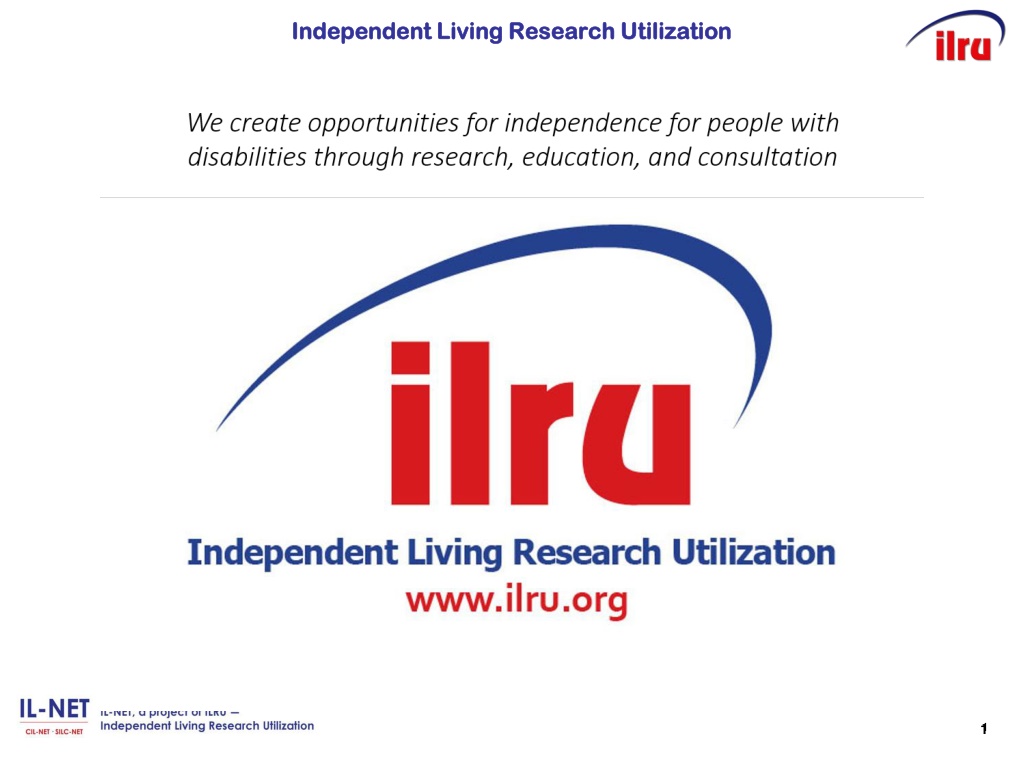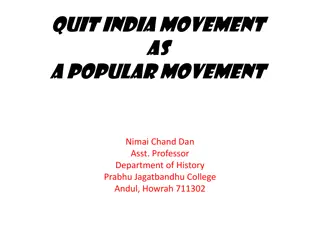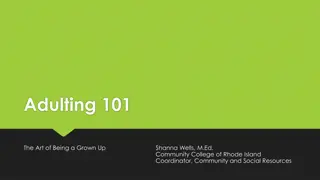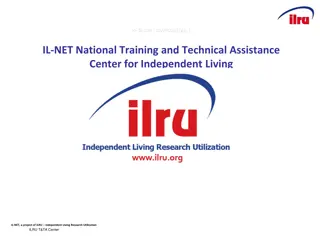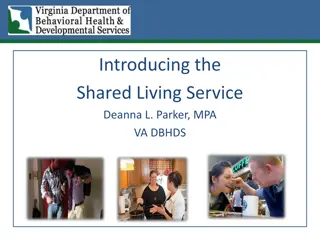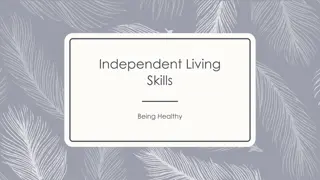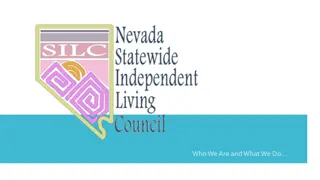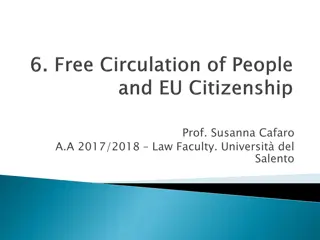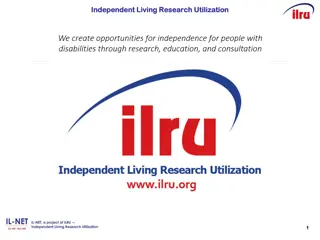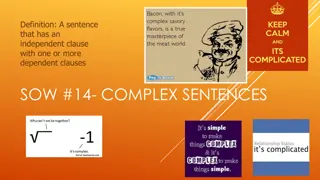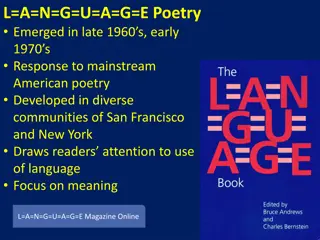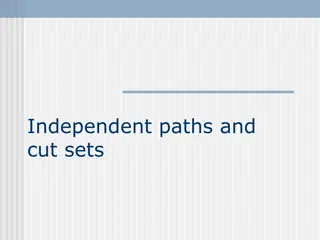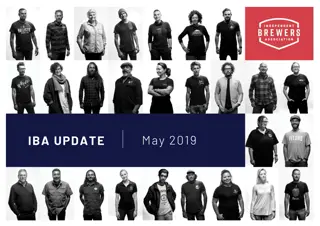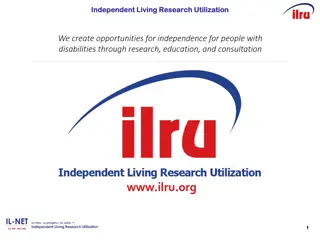Evolution of Independent Living Movement
Delve into the core of the Independent Living Movement that integrates consumer-driven services for a holistic experience. Explore the impact of history, philosophy, and social context on the movement, led by influential figures such as Ed Roberts and Wade Blank. Learn about the paradigm shift towards Independent Living, Disability Rights, Culture, and Pride, distinct from traditional paradigms. Embrace person-first language and the rich history that parallels civil rights and social movements of the late 1960s and early 1970s.
- Independent Living Movement
- Disability Rights
- Consumer-driven Services
- Holistic Experience
- Social Context
Download Presentation

Please find below an Image/Link to download the presentation.
The content on the website is provided AS IS for your information and personal use only. It may not be sold, licensed, or shared on other websites without obtaining consent from the author. Download presentation by click this link. If you encounter any issues during the download, it is possible that the publisher has removed the file from their server.
E N D
Presentation Transcript
Independent Living Research Utilization Independent Living Research Utilization 1 1
Get to the Core of It: Get to the Core of It: Integrating CIL Core Services for a Integrating CIL Core Services for a Holistic Consumer Experience Holistic Consumer Experience Connecting IL Philosophy and Connecting IL Philosophy and Seamless Consumer Seamless Consumer- -Driven Service Delivery Driven Service Delivery Presenters: Presenters: Bruce Darling Bruce Darling Kimberly Tissot Kimberly Tissot May 1, 2018 May 1, 2018 Tempe, AZ Tempe, AZ 2
IL History & Philosophy and IL History & Philosophy and Impact on Core Services Impact on Core Services Bruce Darling Bruce Darling 3
First a Word About Language First a Word About Language Person First and Identity First Language Both are acceptable within the Disability Community. We will use a combination of both. Special Needs is not approved by the Disability Community. Don't use Euphemisms! 4
Social Context for the Independent Social Context for the Independent Living Movement Living Movement The history of the independent living movement and its driving philosophy also have much in common with other political and social movements that flourished the late 1960s and early 1970s. Civil Rights Deinstitutionalization Demedicalization Self-Help Consumerism 5
Early Leaders of the Independent Early Leaders of the Independent Living Movement Living Movement Ed Roberts Berkley, California Wade Blank Denver, Colorado 6
Independent Living Paradigm Independent Living Paradigm The Independent Living Movement introduced a new paradigm - the Independent Living, Disability Rights, Culture and Pride Paradigm which significantly differed from the Medical, Rehabilitation, and Charity Paradigms. 7
Comparing the Medical Model and Comparing the Medical Model and Independent Living Paradigms Independent Living Paradigms Definition of the Problem Medical Model: Impairment (physical or mental); lack of vocational, political or social skills; lack of education or socio- economic status Independent Living Model: Dependence on professionals, family and others; hostile attitudes and environments; lack of legal protection and recognition of inherent worth of people with disabilities 8
Comparing the Medical Model and Comparing the Medical Model and Independent Living Paradigms Independent Living Paradigms, cont , cont d. d. Locus of the Problem Medical Model: In the Individual with a Disability (the individual is broken or sick and needs to be fixed or cured ) Independent Living Model: In the environment (physical, socio-economic, political, cultural); in the medical, rehabilitation, service delivery, and charity processes 9
Comparing the Medical Model and Comparing the Medical Model and Independent Living Paradigms, Independent Living Paradigms, cont d. 2 cont d. 2 Solution to the Problem Medical Model: Professional interventions and treatment Independent Living Model: Advocacy, barrier removal, consumer control over services, peer support, and self help intended to advance equitable socio-economic, cultural and political opportunities 10
Comparing the Medical Model and Comparing the Medical Model and Independent Living Paradigms, Independent Living Paradigms, cont d. 3 cont d. 3 Social Role of the Person with a Disability Medical Model: Individual with a disability is a patient or client or recipient of charity Independent Living Model: Family and community members; customers who utilize services 11
Comparing the Medical Model and Comparing the Medical Model and Independent Living Paradigms, Independent Living Paradigms, cont d. 4 cont d. 4 Who Controls Medical Model: Professionals Independent Living Model: Person with a disability or their choice of another individual or group 12
Comparing the Medical Model and Comparing the Medical Model and Independent Living Paradigms, Independent Living Paradigms, cont d. 5 cont d. 5 Desired Outcomes Medical Model: Maximum self-care with daily living; gainful employment; socially defined acceptability Independent Living Model: Independence through control; pride; positive disability identity 13
The Core IL Services were The Core IL Services were established to operationalize this established to operationalize this Paradigm Shift Paradigm Shift Core IL Services Information and Referral Peer Support/Peer Counseling Independent Living Skills Training Advocacy (Individual and Systems) Support with Transition/Community Integration 14
How CILs are Unique How CILs are Unique Kimberly Tissot Kimberly Tissot 15
How are CILs Unique? How are CILs Unique? Created by people with disabilities FOR people with disabilities this automatically makes us different from other organizations! Run and operated by a majority of people with disabilities. Grounded by the Independent Living Philosophy. Empowers people with disabilities to be independent. Promotes disability pride & disability rights. Advocates from the perspective of people with disabilities. Safe place for people with disabilities. Funded via Title VII of the Rehabilitation Act, as amended. 16
Whats not considered consumer driven? What s not considered consumer driven? When the consumer doesn't decide on the direction of their services: Examples: Parents/family members/service providers deciding on goals and services. Services that segregate or remove the rights of people with disabilities (i.e guardianship, day programs, sheltered workshops, etc.). Services to parents/family members. 17
Creating an IL Environment and Seamless, Creating an IL Environment and Seamless, Consumer Consumer- -Directed Services Directed Services Bruce Darling & Kimberly Tissot Bruce Darling & Kimberly Tissot 18
IL Principles IL Principles The Independent Living Movement is founded in the belief that people with disabilities, regardless of the form, have a common history. We have a shared struggle. We are a community and a culture that will advance further banded together politically. Equal opportunities and rights are for ALL. People with disabilities are the best experts on their own needs and should decide what is best for themselves. No person should live in institutions on the basis of a disability. 19
IL Principles IL Principles, cont d. , cont d. Having a disability does not mean a person is sick and requires a certified medical professional for daily living. People learn and grow from discussing their needs, concerns, and issues with people who have had similar experiences. Systemic cross-disability advocacy efforts are needed to ensure that people with disabilities benefit from all that society has to offer. There should be no barriers to independence, includingarchitectural, communication, and attitudinal barriers. 20
IL Principles IL Principles, cont d. , cont d. 2 2 The organizations best suited to support and assist individuals with disabilities are governed and operated by individuals with disabilities. Leadership for independent living and disability rights is vested in individuals with disabilities (not parents, service providers or other representatives). 21
Ideas CILs Should Live By Ideas CILs Should Live By Empowerment We don t reach goals for individuals; we teach the skills that allow them to do for themselves. Inclusion We advocate for individuals with disabilities to be included in integrated environments in the classroom, employment, housing, leadership roles, and in discussions that impact their lives and the disability community. Independence Individuals with disabilities have the right to control their own lives and make decisions about what s best for them. We believe every individual can be independent. 22
Ideas CILs Should Live By Ideas CILs Should Live By, cont d. , cont d. Equality We advocate for equal rights and access, not special treatment. Disability Pride Disability is not a negative word. It means we are more adaptable. We are proud of who we are, and the barriers we have overcome have only made us stronger. 23
Stay Focused on IL Stay Focused on IL Don't mission creep Stay focused on the mission of IL. Don t chase funding that doesn't include and benefit people with disabilities. Only commit to programs & projects that promote IL. Become the expert about IL and become an important voice at all tables. Mission Creeping damages the IL Philosophy! 24
Creating an IL Environment Creating an IL Environment When people first connect with the CIL, they should immediately recognize that this place is different from other organizations. 25
Creating an IL Environment Creating an IL Environment, cont d. , cont d. Establishing a physical/organizational environment that reflects our philosophy and the diversity of our movement by: Ensuring a fully accessible space and services. Celebrating our movement and pride through artwork. Displaying images of diverse disabilities, races, ethnicities, and cultures which ensures everyone feels welcome (and safe). Ensuring staff have disabilities and other characteristics that are representative of the community you serve. 26
Creating an IL Community Creating an IL Community CILs are more than service delivery centers. Establish welcoming community space with resources to ensures that we can be community-building centers that promote the Independent Living and Disability Rights movements. Create social opportunities to build community. Include opportunities for everyone including people with the most significant disabilities to participate in our systems advocacy and operationalize our philosophy. 27
Combatting ableism, including internalized Combatting ableism, including internalized ableism, is critically important ableism, is critically important Ableism* is pervasive and creeps into our consciousness in many different ways. Keeping that in mind helps us combat ableism in every form. *Ableism: discrimination or prejudice against individuals with disabilities. ~ Merriam-Webster 28
Creating a Seamless Service Delivery Creating a Seamless Service Delivery System System Have you ever experienced the social service run- around? What was it like? How did it make you feel? 29
Creating a Seamless Service Delivery Creating a Seamless Service Delivery System System, cont d. , cont d. We don t want our consumers to have these frustrating experiences at our centers! Instead, we need to be thinking, how easy can we make this? 30
Creating a Seamless Service Delivery Creating a Seamless Service Delivery System System, cont d. 2 , cont d. 2 CILs can do a great deal to address how services we provide can operationalize our philosophy and be as seamless as possible. 31
Wise Words to Live By They may not remember what you said, but they will remember how you made them feel. 32
IL History & Philosophy Resources IL History & Philosophy Resources Creating Disability Culture in CILs (recorded webinar) - http://www.ilru.org/training/creating-disability-culture- centers-for-independent-living IL History and Philosophy: Orientation for IL Staff (4 recorded modules) - http://www.ilru.org/il-history-and- philosophy-orientation-for-il-staff History of Independent Living (RapidCourse tutorial) - http://www.ilru.org/training/foundations-independent- living-series 33
CIL CIL- -NET Attribution NET Attribution Support for development of this technical assistance information was provided by the Department of Health and Human Services, Administration for Community Living under grant number 90ILTA0001. No official endorsement of the Department of Health and Human Services should be inferred. Permission is granted for duplication of any portion of this information, providing that the following credit is given to the project: Developed as part of the CIL-NET, a project of the IL- NET, an ILRU/NCIL/APRIL/USU-CPD National Training and Technical Assistance Program. 34
